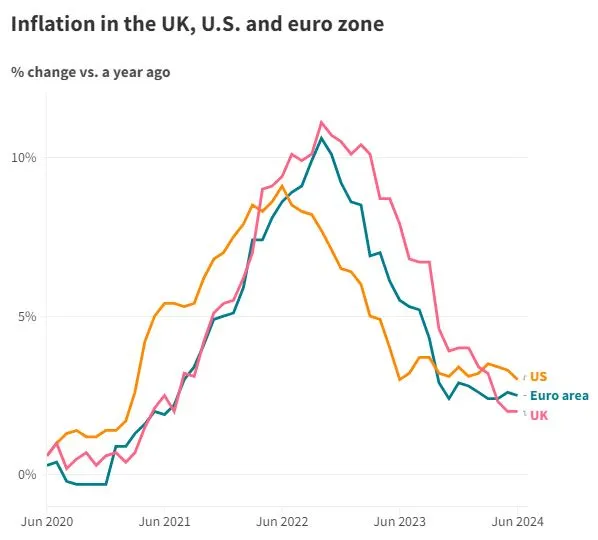The European Central Bank (ECB) has recently indicated potential future rate cuts. This announcement follows a period of heightened inflation and persistent economic challenges. The primary keyword “European Central Bank” is central to understanding the broader economic landscape. Interest rates, inflation, and monetary policy are key areas of focus. The ECB’s decisions significantly impact these factors.
Current Economic Landscape
The European Central Bank’s decision to signal future rate cuts comes after a unanimous vote to maintain current interest rates at 3.75%. This decision was widely anticipated given the ongoing inflationary pressures, particularly from the labor market. Euro zone headline inflation dipped slightly to 2.5% in June, but core inflation, excluding volatile components like energy and food, remained steady at 2.9%.
ECB President Christine Lagarde emphasized that the central bank remains data-dependent. She highlighted that future rate cuts are “wide open” depending on economic indicators. This cautious yet open approach reflects the ECB’s commitment to stabilizing inflation while supporting economic growth.
Inflation and Wage Growth

Source- CNBC
Inflation remains a critical concern for the European Central Bank. While headline inflation has shown some signs of easing, core inflation remains stubbornly high. This persistent inflation is driven by several factors, including wage growth. Wages have been rising at an elevated rate, partially compensating for the past period of high inflation. However, higher nominal wages alongside weak productivity have led to unique labor cost growth.
Lagarde noted that despite some deceleration in labor costs in the first quarter, wages are still rising significantly. This wage growth contributes to domestic price pressures, complicating the ECB’s efforts to manage inflation. As a result, the ECB continues to monitor wage trends closely as part of its broader monetary policy strategy.
Monetary Policy and Economic Indicators
The European Central Bank’s monetary policy remains focused on maintaining restrictive financing conditions to control inflation. However, the ECB has not pre-committed to a specific rate path, instead opting to evaluate economic data on a meeting-by-meeting basis. This flexible approach allows the ECB to respond dynamically to changing economic conditions.
Recent data supports the ECB’s medium-term outlook for inflation to converge at 2%. The ECB believes that inflation levels will fluctuate for the rest of the year but decline overall in the second half. This anticipated decline is due to weaker labor costs, the impact of monetary policy, and the fading effect of past price shocks.
Market Reactions and Future Expectations
The market response to the European Central Bank’s announcement was relatively muted. Expectations for a rate hold in July meant European markets saw little change following the decision. The euro continued to trade slightly lower against the U.S. dollar and higher against the British pound. Stocks were broadly higher across the region.
Market pricing suggests firm expectations for two more 25 basis point cuts this year, one in September and another in December, with a pause during the ECB’s October meeting. This anticipated rate path aligns with the ECB’s stated commitment to data dependence and gradual policy adjustments.
Kiran Ganesh, Chief Investment Officer at UBS Global Wealth Management, suggested that now might be the time to shift cash and lock in current interest rates before they come down. He also noted that both the euro and the U.S. dollar are likely on similar interest rate paths from here on. This could influence currency markets, especially as other central banks, like Switzerland’s, approach the end of their rate-cutting cycles.
Comparative Central Bank Policies
The European Central Bank’s approach to interest rates and inflation can be compared with other major central banks worldwide. For instance, the U.S. Federal Reserve is also expected to start cutting rates soon. Market participants largely anticipate the Fed to begin rate cuts in September, potentially trimming rates at least two times by January 2025.
Switzerland, Sweden, and Canada have all lowered rates already this year. However, recent sticky inflation data in the U.K. reduced market bets on an August rate cut from the Bank of England, boosting the British pound. These varied approaches highlight the unique economic conditions and policy responses in different regions.
Challenges and Opportunities Ahead
The European Central Bank faces several challenges as it navigates its monetary policy. High inflation, driven by wage growth and other factors, remains a significant concern. Balancing the need to control inflation while supporting economic growth is a delicate task. The ECB’s decision to maintain flexibility and respond to data as it comes is a prudent approach in this complex environment.
However, there are also opportunities. The ECB’s monetary policy can help stabilize inflation over time, providing a more predictable economic environment. Additionally, gradual rate cuts could support economic growth by making borrowing more affordable for businesses and consumers.
Conclusion
In summary, the European Central Bank has signaled the possibility of future rate cuts, reflecting its data-dependent approach to managing interest rates and inflation. By maintaining restrictive financing conditions while closely monitoring economic indicators like wage growth, the ECB aims to balance inflation control with economic support.
The European Central Bank’s decisions have significant implications for the euro zone’s economic landscape. As the ECB continues to navigate these challenges, its commitment to data-driven policy adjustments will be crucial. Market participants and policymakers alike will closely watch the ECB’s actions in the coming months, anticipating how future rate cuts might shape the economic outlook.
This period of careful observation and gradual adjustment underscores the importance of central banks in managing economic stability. The European Central Bank’s ongoing efforts to control inflation while fostering growth will remain a central focus in the global economic narrative.
Click here to read our latest article Surge in Gold Near Record Levels

